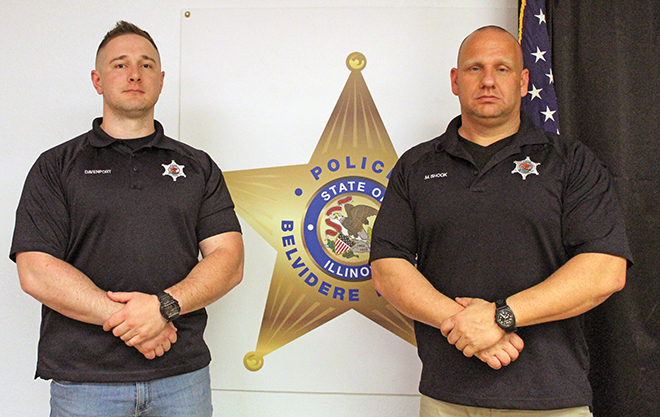CPA: Defensive Tactics

Officers Ryan Davenport and Matt Shook instructed the Defensive Tactics class during the 2021 Citizens Police Academy.
By Anne Eickstadt
Editor
Previous Citizens Police Academy class feedback resulted in a defensive tactics session with Officers Matt Shook and Ryan Davenport being added to the course.
The hands-on defensive tactics CPA class they taught in 2020 resulted in only a couple of students participating so they decided to switch things up and show police videos from around the world showing real situations. Some of the incidents were handled very well and many of them could have been handled better.
Shook informed the group that Belvidere police officers are required to take sessions on Constitutional Law twice a year. They also get out the mats and do hours of hands-on defensive training twice a year.
“We get the training we need to keep the community safe,” Shook said. “We learn about all the advancements in technology. Police officers are being attacked more often now than in the past. We are just not dying as often. We (at BPD) are blessed with the training and equipment we have. “
Shook and Davenport pointed out pre-attack indications that the suspect is displaying before making a move. “Generally, if someone gets hit first, they lose.”
“It’s happened to me once,” said Davenport. “I was handcuffing a guy for a felony and his girlfriend knocked my hand away so, when he took a swipe, he connected. I controlled the situation, though, and finished cuffing him. However, that move got his girlfriend a felony conviction as well.”
“Everyone gives off cues before they attack,” said Shook. “There is ‘target glancing’–they will keep glancing at the gun/Taser they plan to grab or check out their escape route. ‘Picking’ is when they keep adjusting their clothing to prepare for flight or fight. Often, they will rub or scratch their face–there are many blood vessels in the face and, as the nervous adrenaline flows, their face itches.
“Whether you are in the police or the military, you learn about OODA–Orienting, Observing, Decisions, Acting. The OODA loop is the cycle developed by military strategist and United States Air Force Colonel John Boyd. The approach explains how agility can overcome raw power in dealing with human opponents. An individual that can process this cycle quickly, observing and reacting to unfolding events more rapidly than an opponent, can thereby ‘get inside’ the opponent’s decision cycle and gain the advantage.”
Most of the videos the officers showed were raw, unedited footage. (Only one particularly violent video was edited–both police officers were shot and the suspect drove away after being shot himself, only to die from his wounds a few blocks away.
Shook knew the backstory of that video. One officer, who was shot in the heart, was airlifted to a nearby hospital where a visiting cardio specialist cracked open his chest and massaged his heart to keep him alive. The bullet was extracted and that officer lived.
The first video shown was of the police responding to a call of an armed robbery. They saw the suspect calmly exit the store. They asked him to stop and come over to talk with them. Instead, he remained where he was, just outside the door where innocent bystanders were coming and going. He stayed half turned away from the officers instead of turning to face the one talking to him.
Eventually he turned toward the officer, brushing his hand over the front of his shirt before flipping it up to ‘prove’ he was unarmed. A fellow officer said that he saw the gun in his waistband.
The suspect drew his gun and fired at the officers before taking fleeing. Now having a clear line of fire, the officers shot him.
“What did you notice about the suspect?” the class was asked.
It is not natural behavior to talk over your shoulder to someone instead of immediately turning to speak with them.
His hand brushed over his shirt to make sure the gun was where he thought it was tucked in his waistband.
His elbow flared out as he turned his hand to grab the gun.
Why didn’t the officers make a move sooner?
Too many innocent bystanders and no clear line of fire. “We have to know what’s on the other side of the suspect. We are accountable for every bullet that comes out of the gun. The body camera may have seen an opportunity sooner but the body cams see in hi-def and officers do not see in hi-def.
“In cities with populations under 400,000, the typical officer will never have to draw his gun. A lot of officers get hurt because they are reluctant to draw their gun.”
The class was asked to watch more videos and spot indications that the suspect was about to do something unexpected. There were numerous indications of target spotting where the suspect kept glancing to the side or checking out the weapons on an officer’s vest. Elbows would flare as the suspect reached for a concealed weapon on his person. If the students missed a clue, the officers would point it out.
They explained the psychological differences that a handgun and a Taser have for both the suspects and the officers and which one is more effective, or ineffective, in different situations.
“If we sound brusque or commanding, it is because we are trying to control the scene so nothing bad happens,” said Shook. “50 percent of police officers have PTSD [Post Traumatic Stress Disorder]. It’s a great job, but there’s a price to pay. The Belvidere Police Department makes sure counseling is available for officers, Dispatch, the Belvidere Fire Department‒everyone involved in an incident.”



